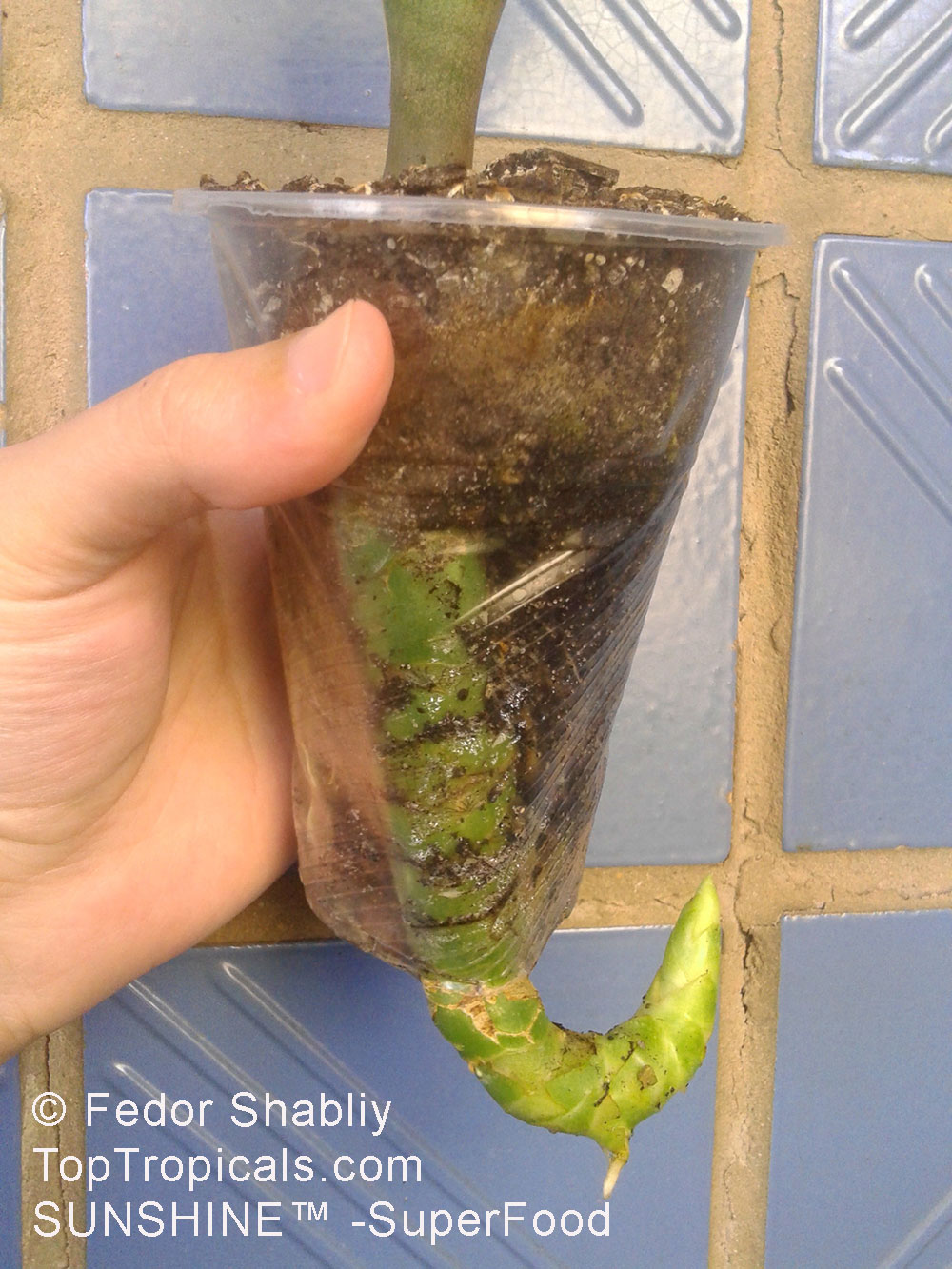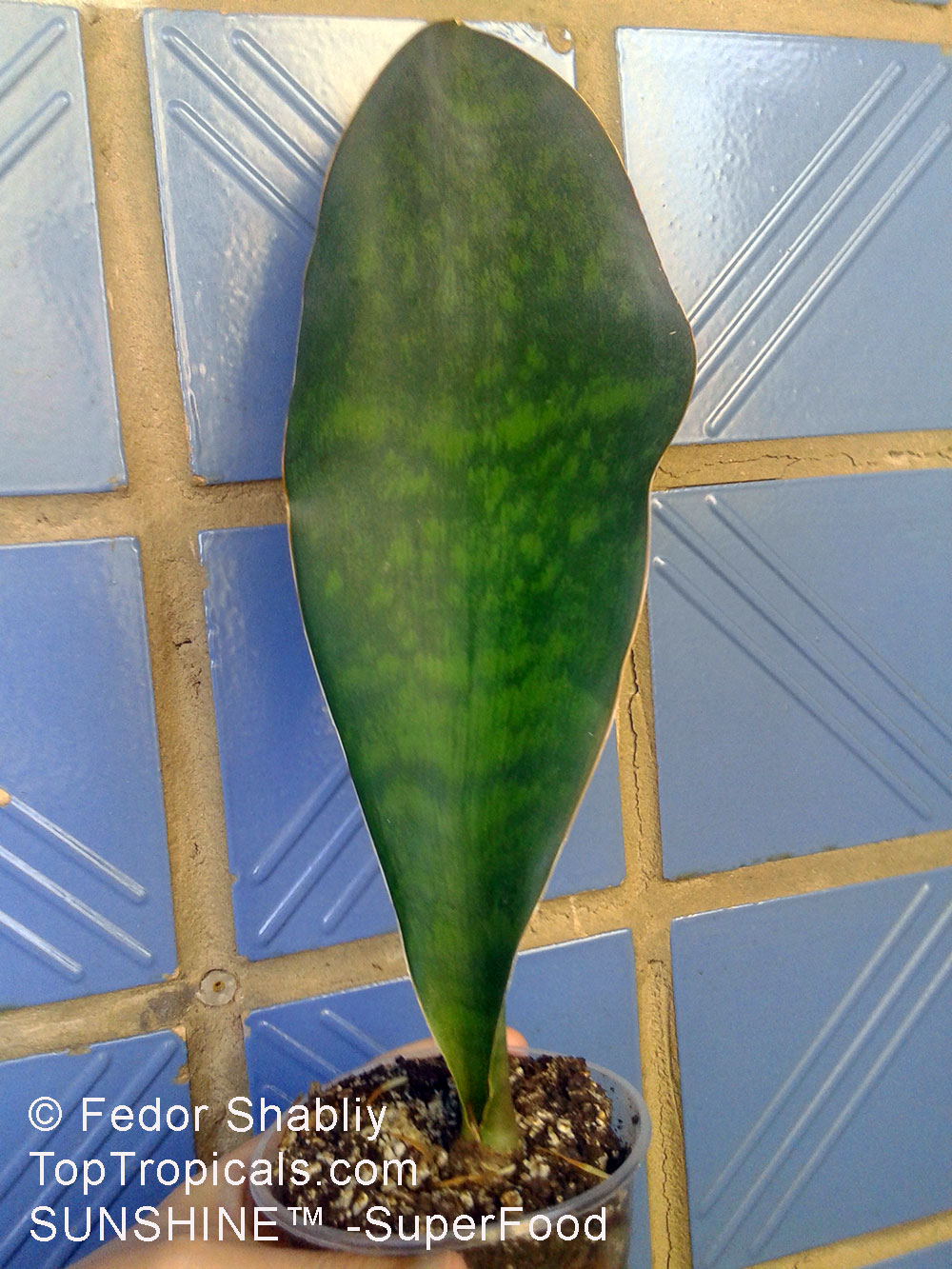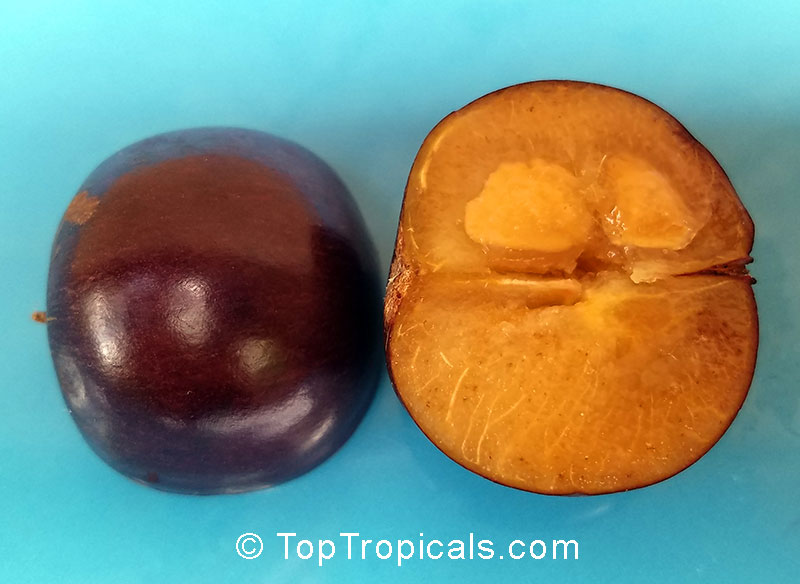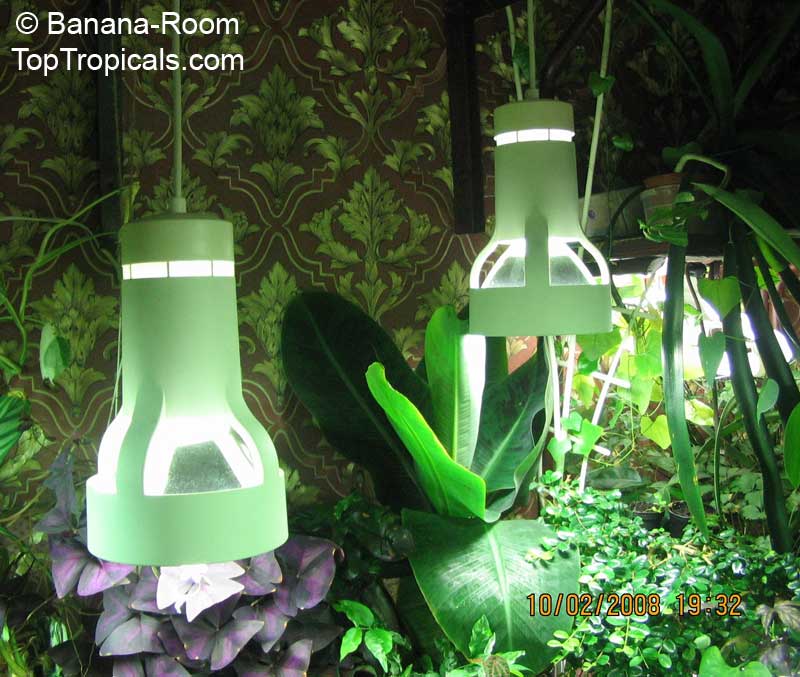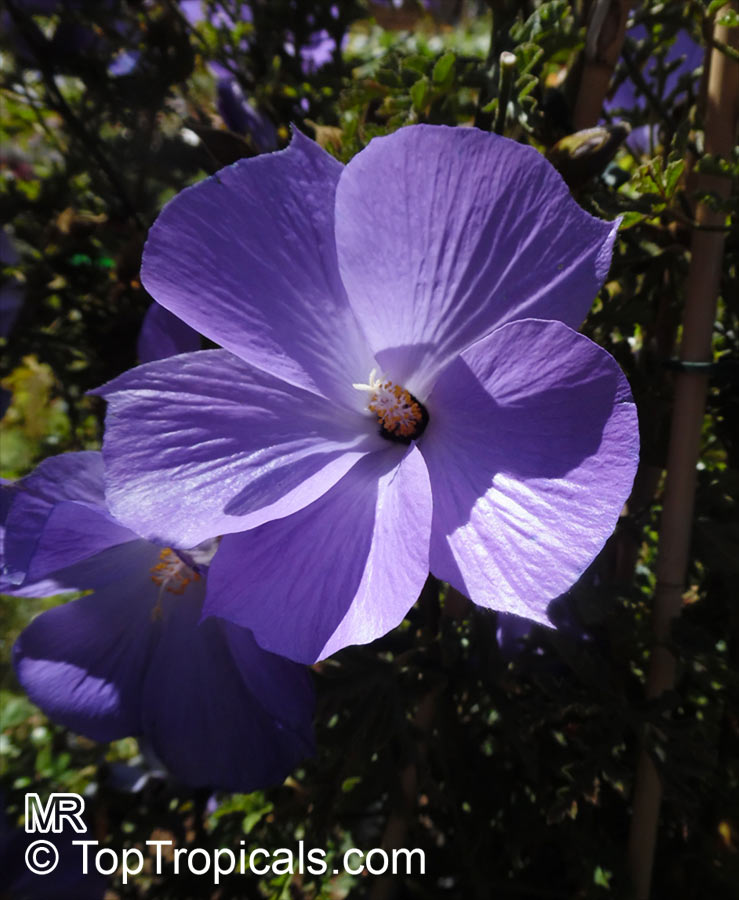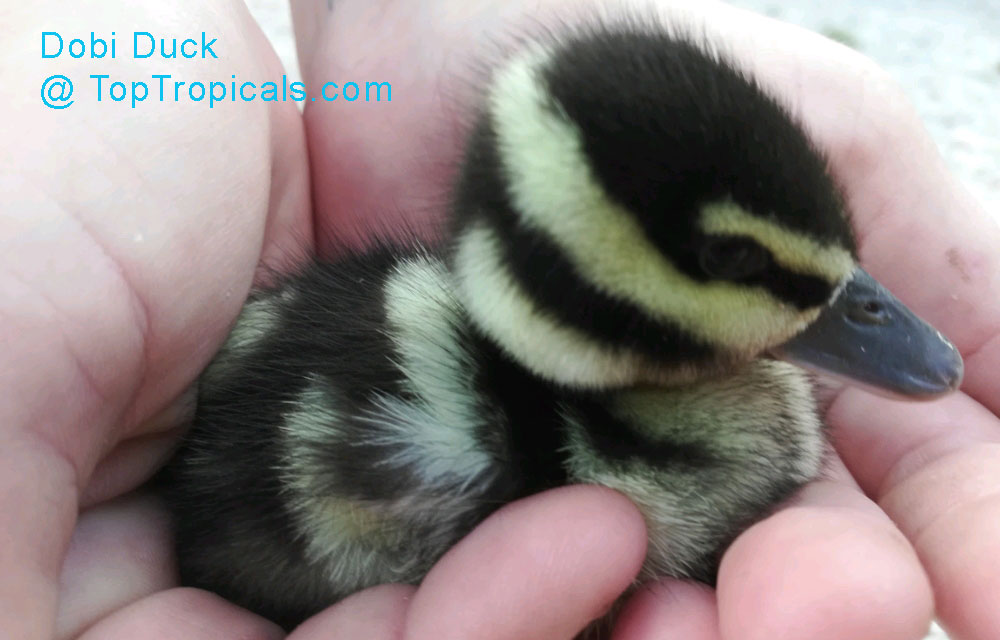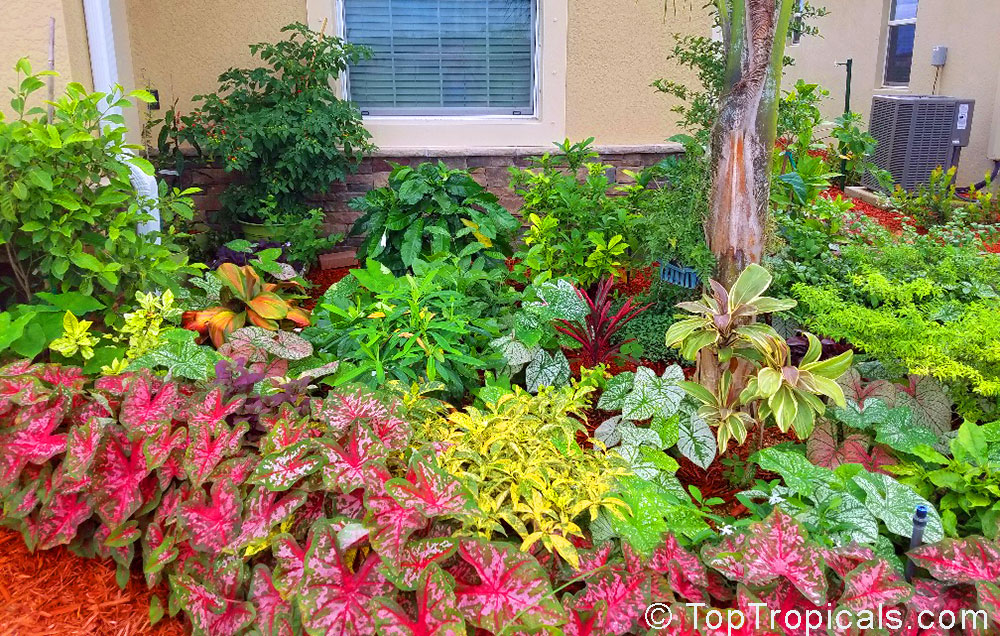Garden Blog - Top Tropicals
Date:
Amazing root growth after treatment of SUNSHINE-SuperFood!
This Sansevieria grandis leaflet planted indoors in a plastic cup was treated with SuperFood once a week, along with regular monthly N-P-K, for a couple of months. On the photo, you actually see not just a ginormous root but a whole new plant started forming through the colossal size root sucker trying to find its way out. A pretty impressive result for a small plastic cup! The cup was protected from the sunlight, sitting inside of a dark planter. The plant received filtered light sitting on a windowsill with Eastern exposure.
Date:
Q: What is the best time to start tropical plants from seeds? Should I wait till spring?
A: If you
want to feel happier, get into gardening. If you want to feel God, start
plants from seeds and watch New Life grow from a tiny grain. Fall is a perfect
time to start tropicals from seed.
Traditionally, people prefer sowing seeds in Spring, especially
temperate species for a vegetable garden: tomatoes, peppers, cucumbers... My
grandmother up North started them in early Spring in paper cups on a windowsill,
then once the temperatures went just above freezing, she planted them out in the
garden beds, and that early start always helped her to have the best early
crop in the neighborhood.
When we deal with tropical plants, "just above freezing" is not warm
enough. Which means you have to grow small babies indoors for quite a while,
providing additional heating when needed. Heating pads always work best. If you
keep your living space around 75F (ideal for many species), this is a
perfect temperature to get your seeds started. Tropical plants are not like annual
tomatoes that try to grow through the season as fast as possible. They take
time. So the sooner you start, the more chances to get small seedlings just in
time when Spring air outside is "warm enough" for those tropicals - at least
in 70's.
A great advantage of starting tropical seeds indoors is controlled
temperature and moisture. In the plant world, environment extremes are not good
for the germination process. Mild conditions of your home or a greenhouse
create better chances for successful growth. Seeds won't get overheated in the
hot Summer sun, and won't rot because of a sudden heavy rain. Just keep in mind
that some species require light for good germination.
For the best seed germination:
- Use only well-drained mix - we recommend special Seed Germination Mix #3, professional grade. Put seeds not too deep
(1/2 inch deep or less) to allow air circulation
- Soak large seeds for a few hours with Sunshine-S solution
- Keep warm (75-85F) and in bright light
- Keep soil slightly moist but not soggy
- Apply micro-element booster SuperFood to baby seedlings for vigorous growth
Date:
Flacourtia indica - Governors plum
Governors plum, Madagascar Plum, Batoko palm - is a tropical or
subtropical small shrubby tree. It is cultivated in tropical regions as a hedge plant
and for its deep red acid fruits resembling small plums. The fruits are
about one inch wide and can be eaten fresh or made into preserves. They are sweet
and sour, with a texture and flavor similar to a plum. Fruits mature after
one to two months from flowering.
The tree is easy to grow, self-fertile and doesn't require much care,
not fussy about soil and very forgiving if you forget to water it.
Seeds germinate readily, but it takes a while until the seedling is
ready to be transplanted into a big pot or in the ground. If you plant them now,
by spring you have a chance to get the little tree ready to go!
Date:
Lighting for overwintering tropical plants indoors
Q: Days are getting shorter and darker... I brought my tropical plants indoors for overwintering (I live in Atlanta, GA). Could you give me some advice on what lamps should I use for additional lighting of my plants?
A: Indoor
plants are very unlucky: they have to grow in "caves," and everybody knows
that plants don't grow in the caves. The luckiest plants win sunny windowsills,
but even there they dwell rather like in underbrush under tall trees, where
the sun illuminate them only early in the morning or in the evening, and its
light is diffused by foliage.
Usually domestic plants are in desperate lack of illumination not only
in winter, but also in summer. No light - no growth, no flowering. So, plants
need extra light to compensate the lack of illumination in the "room-cave"
conditions.
Before you will start any practical actions to help your plants, you
need first to decide whether you are going to set an additional illumination,
or provide full lamplight. In the case of just additional illumination, rather
inexpensive luminescent lamps will do, and you don't have to think about
their spectrum. Continue reading...
Date:
Improving cold hardiness before winter: fertilizer and micro-elements
Q: I live in New Jersey and it is getting cool here, with temperatures in the upper 40s, but my tropical plant collection is in a heated sunroom (still around 70s). Should I continue fertilizing my plants? And if yes, my second question about deciduous Sugar Apple tree. Should I continue fertilizing it until it drops leaves?
A:
First of all, even though you live outside tropical
climate, your plants enjoy warm temperatures year round,
and can be treated like if they were in a Southern
garden.
Plant nutrients, both macro-elements (regular
fertilizer) and micro-elements (such as iron, manganese,
magnesium, copper, and other elements) play an important
role not only in overall plant health but also in plant
hardiness.
The rule of thumb is, even in warm climates we cut off
any fertilizer by the end of October. You still have
time for the last treatment this year (next will be in
March, or when your plants start showing new growth).
You may apply just a bit of slow-release granulated
fertilizer, or water-soluble by foliar spray, diluted
1/2 of label strength, to all evergreen species in your
collection.
The most important application before winter is
micro-elements and other plant boosters that will help
you plant collection survive winter months with a
shorter daylight and cooler temperatures. Now it is a
perfect time to make these simple steps:
1) Miscro-element applications, any one of: Superfood, Iron Supplement, Greenleaf.
2) Sunshine-T application: for
improving cold hardiness, plus immune system resistance
to insects and deceases.
3)
Sunshine-Honey application for all fruit trees to
encourage bigger and sweeter fruit next year.
Regarding your second question. Deciduous tropical plants like Annonas, Adeniums, Plumerias, etc - do not need regular fertilizer at this time, however, go ahead and apply microelements Superfood complex, as well as Sunshine-Honey, while leaves are still green. These two will give a kick-start to provide better flowering in spring, and production of sweeter fruit later.
Check out SUNSHINE boosters - all with free shipping!

Date:
Alyogyne: Blue Hibiscus with prismatic effect of peacock feathers...
By Mark Hooten, the Garden Whiz.

Certain plant families contain many members which I consider outstanding and requiring much admiration. One of these families is the Malvaceae, known as the "Hibiscus (or Mallow) Family". This group contains many members whose ease of growth and visual impact is undeniable. Among those which really stand out is a group of species from far-off Western Australia called Alyogyne. They are especially special! Continue reading...
Date:
Bilimbi, Cucumber tree, Tree Sorrel
Ethnic names are: Kamias, Belimbing Asam, Belimbing
Buloh, Bimbiri. This rare exotic fruit is very popular
in Thailand, Malaya and Singapore. In India, where it is
usually found in gardens, the bilimbi has gone wild in
the warmest regions of the country. Outside native
habitat, Bilimbi is hard to find plant, very few growers
produce them, although it is not so hard in cultivation.
The bilimbi is closely allied to the carambola but quite
different in appearance, manner of fruiting, flavor and
uses. The only strictly English names are "cucumber
tree" and "tree sorrel". "Bilimbi" is the common name in
India and has become widely used. Many people are more
familiar with the close ralative - Averrhoa carambola - Star
Fruit, which foliage looks very similar to bilimbi. The
bilimbi leaves and taste of fruit are quite similar to
those of the
Phyllanthus acidus - Otaheite Gooseberry),
although these plants are not related.
Continue reading...
Date:
Butterfly Garden from Anna Banana
Butterfly facts
1. There are approximately 20,000 different species of
butterflies, the largest of which is the Queen Alexandra
Birdwing with a wingspan of 11 inches.
2. Female butterflies can lay over 1000 eggs during their
short lifetime.
3. Butterflies lay their eggs on host plants which usually
hatch within a few days, then turning into caterpillars.
The caterpillar will then eat until it sheds it's skin
several times, called instars, finally emerging from the
chrysalis as a beautiful butterfly.
4. Butterflies are born to breed, their goal being to mate
and begin the cycle again. Most live only a few days
except the Monarch which can live up to six months.
5. Monarch butterflies migrate to Mexico every fall and
remain there until spring when they make the return
migration.
6. Due to the continuing destruction of the rain forests,
where the largest population of butterflies are found,
their numbers are dwindling. We encourage you to plant a
butterfly garden!!
Remember:
- A sunny, less windy location is best, however, Zebras
love to float in the shade of bushes and trees.
- The more host and nectar plants you have, the more
butterflies will be attracted to your garden.
- Butterflies "puddle". They like a wet sandy area where
they congregate and sip minerals and nutrients from the
wet sand and water.
- Rocks to rest and enjoy their beautiful garden, and
don't forget a bench or hammock for yourself.
FREE butterfly garden guide from Anna Banana
For our local Florida customers, it is a perfect time now
to start a garden with plants for butterflies that will
appear first thing in Spring. Establish these plants now
for the Spring blooms that will attract the Beauty into
your garden!
Stop by our Garden Center to check out our Butterfly Plants display, or
simply call Anna Banana for a free consultation on
Butterfly Garden at 239-771-8081.
Hurry up while butterfly plants are on 4-day sale!
Date:
Dobi Duck @ Top Tropicals
Introducing a new member of Top Tropicals Team: Duck Dobi. Full name is Adobe (Acrobat or Photoshop - he is both active and colorful perrrson).
A customer brought us this little guy who was lost on
the street, probably left behind when his Mama took her
babies across the road. (Why did the Duck have to cross
the road after all?)
So Kristi adopted Dobi. He has been doing great for the
last couple of days, decided that Kristi is his Mom so
he is following her everywhere. TopTropicals cats are
excited but staying away knowing better: don't mess with
Mama Kristi!
Those of you who know little secrets how to raise little
ducklings please drop us a line! Dobi is our
first experience in raising something different than
plants or cats!
Date:
October Tropical Garden: to do list
1. Prune. Last pruning before winter. Check the trees and shrubs one more time. Cut away dead wood and remove crossing limbs and branches.
2. Mulch. Continue to mulch to stop weeds and get ready for winter. Keep mulch 1-2 inches away from the stems. Evenings are starting to cool, so it is more comfortable working in the garden.
3. Pest control. Check for mealy bugs and scales. Remember that a garden with many kinds of plants has fewer pests than gardens with lots of mass plantings. So keep up with variety! Avoid pest magnets like Oleander, Oak, Hibiscus which require constant spraying.
4. Propagation. You still can take cuttings but do it as soon as possible. Days are getting shorter and less sunlight signals thу plants to slow down their growth. Cuttings will not root as quickly.
5. Seeds. Consider growing vegetables and perennials from seeds. In mild cooler conditions, seedlings have less stress and get a good start.
